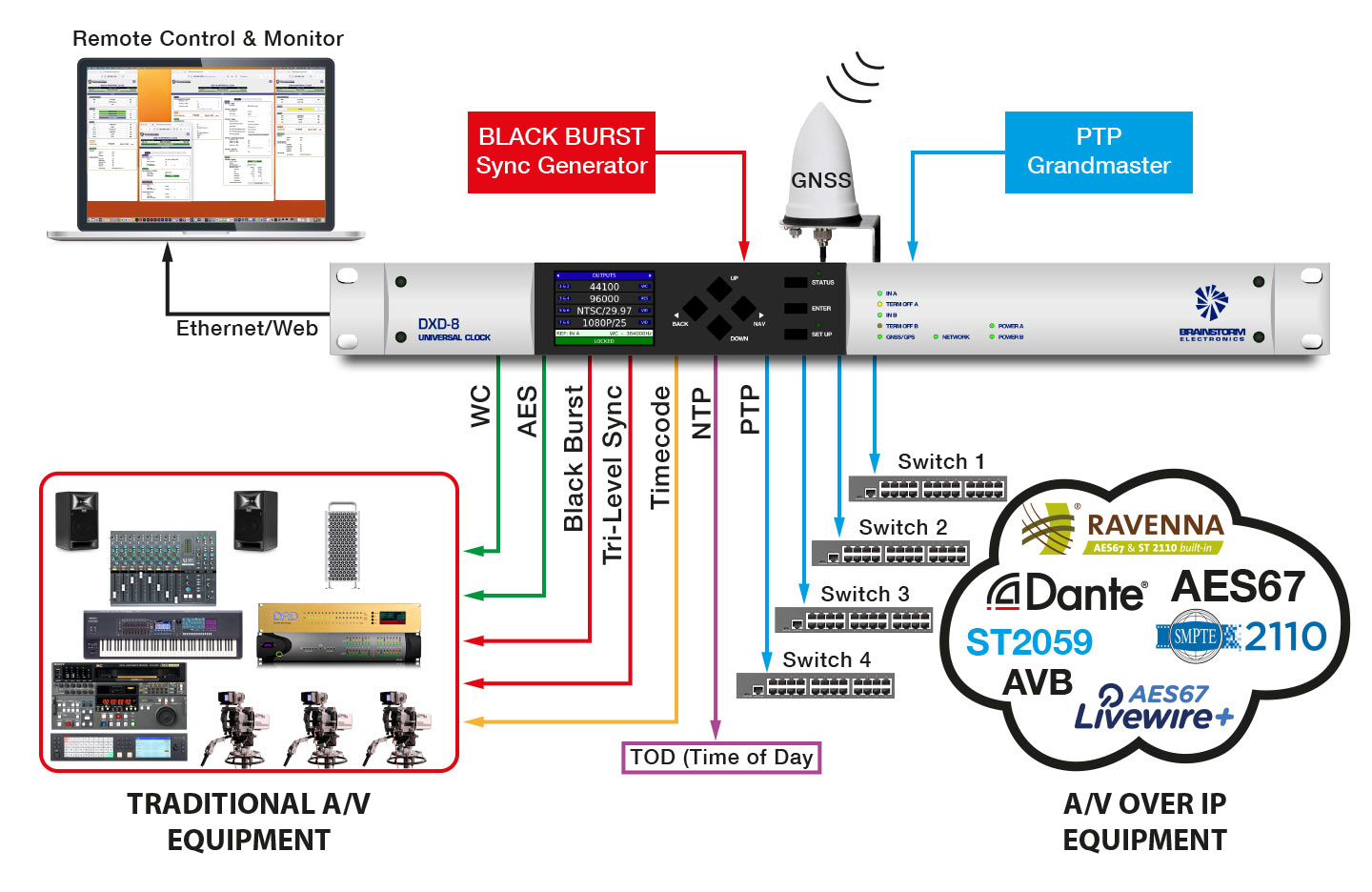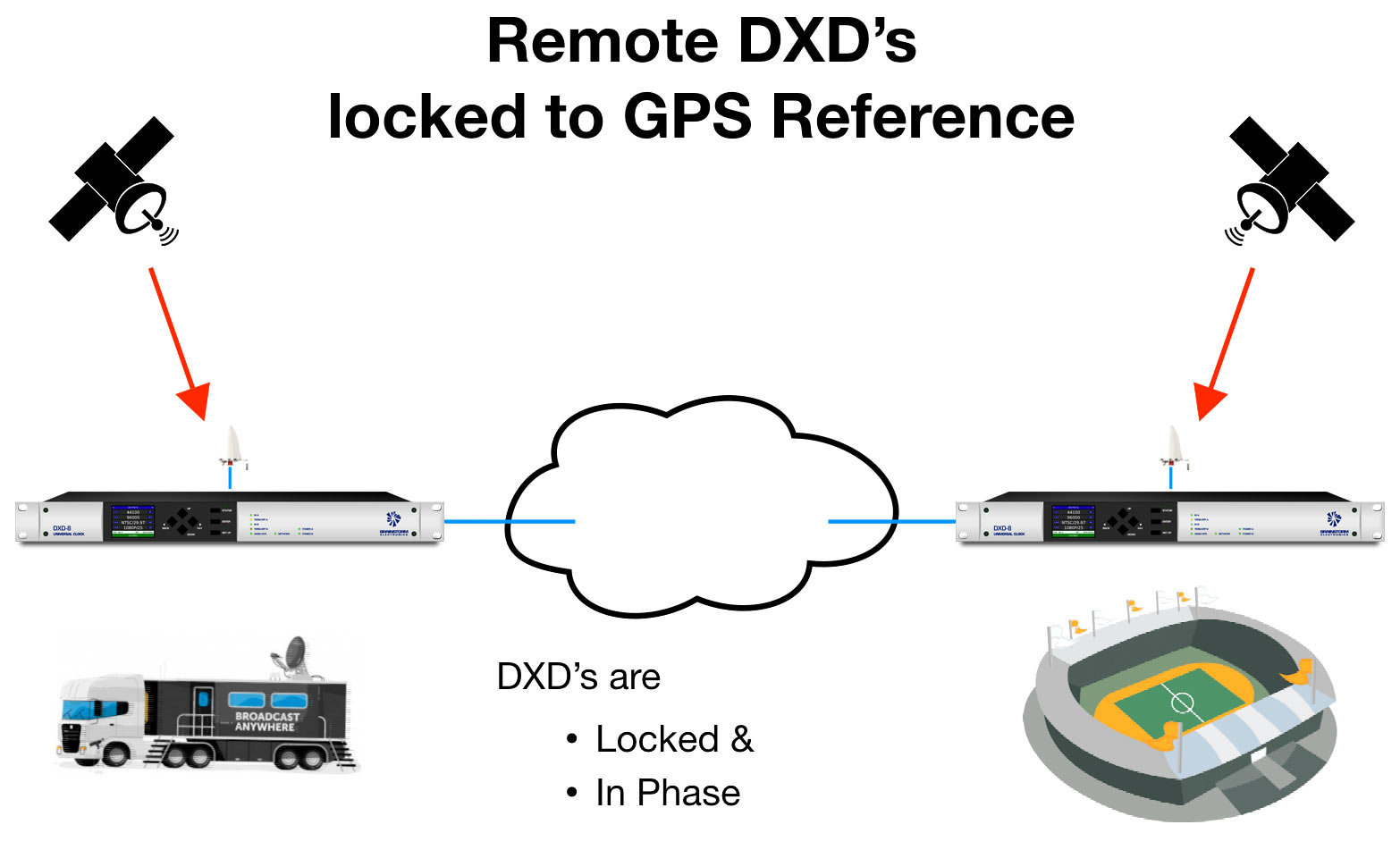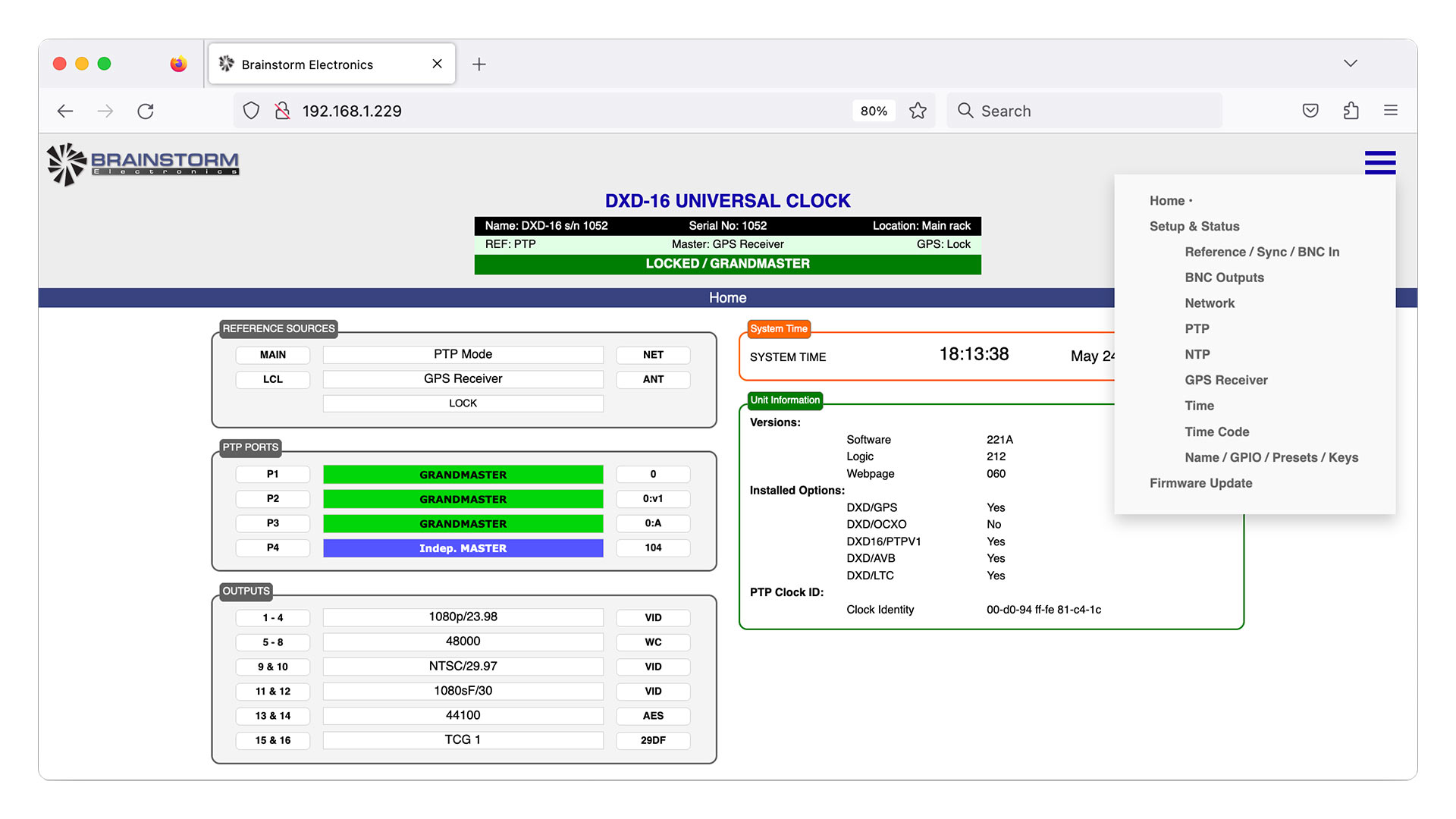DXD-8
UNIVERSAL CLOCK
DXD-8 Universal Clock
A Precision Reference Generator with 8 Universal Outputs and a PTP Option
The DXD series from Brainstorm is designed to ease the transition to IP. The precision multiformat reference generator generates up to 4 independent video syncs and audio clocks simultaneously. With the PTP option, the DXD-8 acts as a clocking bridge between an IP infrastructure and legacy A/V equipment.
Features
Flexibility and easy integration
- 4 separate Reference Generators
- 8 BNC outputs: WC, AES, VID SYNC or 10MHz (user-defined)
- 2 BNC inputs for external references with failover
- NTP Server & NTP Client
- PTP Grandmaster or PTP Slave (w/ PTP option)
- GPS Receiver (hardware option)
- Synchronizes to a legacy reference, a PTP network or GPS
- Generates TOD Time Code (w/ DXD/LTC option)
- Remote control via web browser
- Available options: PTP (v2, v1, AVB) , LTC, GPS, OCXO
IEEE 1588 Network Sync
The optional PTP firmware supports PTP V2, PTP V1 (Dante) and gPTP (AVB). The DXD- 8 can be a PTP Grandmaster or a PTP Slave. Precision Time Protocol (PTP) has been broadly adopted as the network synchronizing standard, which means that the DXD-8 can work in a number of systems. Several PTP profiles are included: AES67, SMPTE 2059 and gPTP.
As a PTP slave, the DXD-8 would synchronize its internal clocks to the PTP Grandmaster while generating the different sync pulses and clocks. Alternatively it can itself fulfill the function of Grandmaster either locked to the GPS signal (option) or to it’s internal oscillator.
The DXD-8 has one Gigabit Ethernet port (RJ45).
Customize Your Unit with User-Assignable BNC Outputs
The DXD-8 generates up to 4 independent sync signals simultaneously and routes them to the 8 BNC outputs. These outputs can be set for any of the generated references, video or audio, giving the DXD-8 great flexibility. This includes: all standard SD and HD video sync formats (Black Burst and HD tri-level sync), word clock and AES11 DARS (standard rates up to 384 KHz and all the necessary pull-up/down, including 24:25 conversions, even VSO) and 10MHz. With the Time Code option, LTC is also included.
Accurate and Versatile Clock Generator
A high-accuracy internal crystal oscillator (TCXO) provides a very stable frequency reference (+/- 1ppm). An optional oven-controlled oscillator (OCXO) can be installed.
External legacy signals can also be used as reference, such as Word Clock, AES, Video Sync (SD & HD) or a 10MHz tone. The generated outputs have extremely low jitter. The output rates are independent from the reference rate which means that any rate can be generated locked to any reference such as 59.97 from 25FPS for example.
PTP Slave or Grandmaster
The DXD-8 can be a PTP slave or a PTP Grandmaster giving the operator exceptional flexibility:
- As a PTP slave, it can generate legacy sync so that the legacy equipment locks to the network;
- As a PTP master, it can lock to an external legacy sync source so that the network locks to the legacy equipment;
- As a stand-alone master, locked to its internal oscillator or GPS, it provides sync to the network via the PTP port and to the legacy equipment via the BNC outputs, simultaneously.
GNSS / GPS
A GPS receiver can be installed in the DXD-8. GPS not only provides an extremely accurate timing source, it also enables DXD’s in remote locations to be locked and in phase with one another. Additionally, with the GPS option, the DXD will have a higher priority as a PTP Grandmaster.
Remote Web Control
Firmware 3.00 (free download) brings Remote Control functionality to the DXD-8 and DXD-16 Universal Clocks via embedded web pages. This new GUI allows an operator to control and monitor the DXD from a standard web browser.
Resilience and Redundancy
When using an external reference, a second source can be connected as fallback in case of failure. If the external reference becomes unusable, the DXD-8 continues generating, locked either to the alternate source or to the internal oscillator and re-locks to the reference when it reappears. These transitions occur smoothly and gradually with no sync shock to the system.
Two external 12VDC power supply can be connected to the DXD-8. It can operate with either of these power sources and they can both act as a back-up for the other with auto switch-over in the event of a failure.
DXD-8 Specifications
| Reference Generator: |
Generates simultaneously up to 4 different rates in any of these formats:
|
| Universal Outputs: | 8 outputs – in 4 pairs BNC – 75Ω Output signal: any of the generated legacy references |
| Oscillators: | TCXO: +/- 1ppm OCXO: +/-10ppb (option) |
| External Sync Sources: | Word clock AES Video sync (Black Burst or HD tri-level sync) 10MHz GPS (Option) PTP (Option) |
| Universal Inputs: |
2 BNC input connectors w/ 75Ω termination switch
|
| NTP Server: | Distributes the DXD-8 System Time to connected NTP Clients |
| NTP Client: | Transfers Time-of-Day from an External NTP Server to the DXD-8 System Time |
| Remote control: | Web browser |
| Battery backup: | An on-board battery keeps the internal backup clock (RTC) running while power is off |
| Presets: | 10 presets can be programmed for quick recall |
| Display: | 2.4” TFT LCD – 240 x 320 resolution |
| Power: | 12 VDC @ 5A – External, switching power supply Dual inputs with auto switch-over for redundancy |
| Dimensions: | 19” x 1.75” x 8” |
| PTP (option): | Complies with IEEE-1588 V2 & V1 + AVB E2E Multicast operation Configurable as a PTP slave (follower) or Grandmaster 1 Gigabit Ethernet port (RJ-45) |
| GNSS/GPS (option): | The DXD-8 can be fitted with an Internal GPS receiver. The option includes an SMA antenna input connector. An antenna is required (not included). |
DXD-8 Resources
Manual & Data Sheet
DXD-8 FAQs
How many different sync signals and rates can the DXD-8 generate simultaneously?
The DXD-8 can generate up to 4 different sync signals similtaneously. These can be WC, AES, Video Sync or 10MHz. They can be routed to any of the 4 pairs of universal output. They can be set to any standard (or non-standard) rate.
Can the DXD-8 be set up to have 8 video sync outputs, 1080p tri-level sync for example?
Yes, the Universal Outputs can be set to any of the formats mentioned in FAQ #1 above, which means that, if 8 outputs of 1080p tri-level sync is what is needed, the DXD-8 can be set up to do just that.
What is the purpose of the DXD-8 Real Time Clock (RTC)?
The RTC is a backup clock used by the DXD-8 to guarantee that Time-of-Day (TOD) will always be present. Here is how it works:
Just after power up, the DXD-8 transfers the date & time information from the RTC to the main System Time (TOD); when the DXD-8 locks to a new reference, if that reference does not have date & time, the TOD simply continues counting along its current time sequence; if it has date & time, that information is transferred to the TOD.
The RTC is battery-powered and is continuously running. It can be adjusted manually or set for automatic update from GPS or NTP in menu 8.2.
What is the best way to use the DXD-8 NTP client?
Menu 6.2 refers to a ‘Pseudo’ Client Mode because, when enabled, the NTP time is not automatically sent out to the server side. Instead, the Time-of-Day received from the external NTP server can be
- transferred manually to the System Time (menu 6.2) or
- transferred automatically to the Real Time Clock (menu 8.2).
When NTP is available, it is recommended to set it to update the RTC automatically in menu 8.2 (AUTO UPDATE RT CLOCK > NTP). This way, the DXD-8 will always start with a relatively accurate TOD (see previous FAQ on the RTC).






